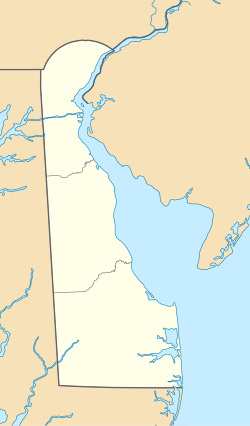
Woodley Park is a neighborhood in Northwest, Washington, DC. It is bounded on the north by Woodley Road and Klingle Road, on the east by the National Zoo and Rock Creek Park, on the south by Calvert Street, on the southwest by Cleveland Avenue, and on the west by 34th Street.
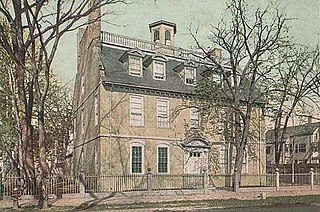
The Warner House, formerly known as the MacPheadris–Warner House, is a historic house museum at 150 Daniel Street in Portsmouth, New Hampshire, United States. Built 1716–1718, it is the oldest, urban brick house in northern New England, and is one of the finest early-Georgian brick houses in New England. It was declared a National Historic Landmark in 1960, and is listed on the National Register of Historic Places.
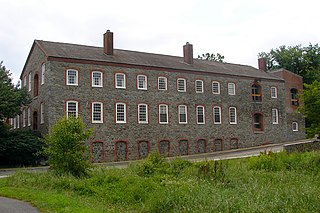
Rockland is an unincorporated community in northern New Castle County, Delaware, United States. It lies along Rockland Road north of the city of Wilmington, the county seat of New Castle County. Its elevation is 194 feet (59 m). It has a post office with the ZIP code of 19732. The Rockland Historic District and William Young House are listed on the National Register of Historic Places. Other landmarks Woodley Park and Mount Lebanon United Methodist Church.

List of the National Register of Historic Places listings in Mercer County, New Jersey

The Blades House, also known as the W.B. Blades House, is an historic house located at 602 Middle Street, in New Bern, North Carolina, in the United States. Built in 1907 for lumber magnate William B. Blades, it was designed in the Queen Anne style by prolific local architect Herbert Woodley Simpson. On January 14, 1972, it was added to the National Register of Historic Places.

This is a list of the National Register of Historic Places listings in Scott County, Minnesota. It is intended to be a complete list of the properties and districts on the National Register of Historic Places in Scott County, Minnesota, United States. The locations of National Register properties and districts for which the latitude and longitude coordinates are included below, may be seen in an online map.
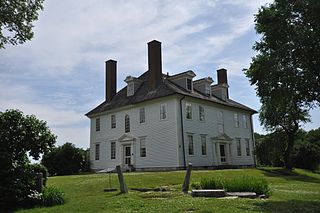
The Jonathan Hamilton House, also known as the Hamilton House, is a historic house at 40 Vaughan's Lane in South Berwick, Maine. Built between 1787 and 1788 by a merchant from Portsmouth, New Hampshire, this National Historic Landmark is a little-altered and high quality late Georgian country house. Acquired by preservationist friends of South Berwick native Sarah Orne Jewett at the turn of the 20th century, it is now a historic house museum owned by Historic New England, open for tours between June and October.

The Mark Temple House is a historic house in Reading, Massachusetts. The 2+1⁄2-story timber-frame house was built c. 1753 by Jonathan Temple, whose family lived all along Summer Street. In the 1850s "Uncle Mark" Temple, remodeled the Georgian style house into the Greek Revival style then still popular in Reading. Among his changes was to turn the original building 90 degrees and raise its foundation. Oscar Foote, a locally prominent real estate developer and businessman, bought the house in 1863.
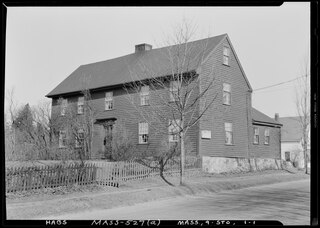
The Jonathan Green House is a historic first period Colonial American house, built c. 1700–1720. It is located at 63 Perkins Street, Stoneham, Massachusetts. It was listed on the National Register of Historic Places in 1984. It is one of the oldest structures in Stoneham, and one of only two structures in Stoneham preserving a nearly intact early eighteenth century form.

The Jonathan Dexter Record House is a historic house at 39-41 Grandview Avenue in Quincy, Massachusetts. This large two-family house was probably built in the 1890s, and is one of the largest and finest Queen Anne houses on Wollaston Hill. It has classic elements of the style, including a three-story tower with conical roof, asymmetrical massing, and a wealth of varying gables and windows. Jonathan D. Record, for whom it was built, was a Boston dry plates manufacturer.

Trinity Episcopal Church is a historic church located at 650 Rahway Avenue in Woodbridge Township of Middlesex County, New Jersey. The third church at this location, it was added to the National Register of Historic Places on May 12, 2004, for its significance in architecture and religion.
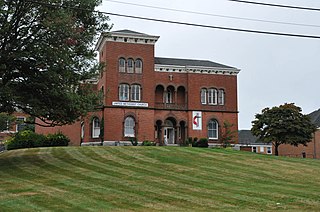
The Jonathan Newton Harris House is at historic house at 130 Broad Street in New London, Connecticut. Completed in 1860 to a design by Leopold Eidlitz, it is a major local example of Italianate and Renaissance Revival architecture. It was built for Jonathan Newton Harris, a prominent local businessman who was mayor of New London at the time of its construction. The house was listed on the National Register of Historic Places on April 27, 1982. It is now home to New London's United Methodist Church.

The Jonathan Sprague House is a historic residence in northwestern Washington County, Ohio, United States. Located atop a bluff above the Muskingum River, it is one of Washington County's most significant houses, due to its age and method of construction.

The Howe-Quimby House is a historic house on Sugar Hill Road in Hopkinton, New Hampshire. Built about 1780, it is a well-preserved example of a rural 18th-century farmhouse with later stylistic modifications. The house was listed on the National Register of Historic Places in 1980.

Leavitt Farm is a historic farmstead at 103 Old Loudon Road in eastern Concord, New Hampshire. It consists of three 19th century farm buildings, including the c. 1847 Greek Revival farmhouse, a large c. 1888 shop and barn, and a 19th-century privy which has been converted into a well pumphouse. These buildings were built by Jonathan Leavitt, a farmer and blacksmith, and were later owned by his son Almah, a sign painter. In the 1980s the property was used by the Concord Coach Society as a headquarters and museum facility. The shop building in particular is notable for its adaptive reuse, and for its second floor ballroom space, an unusual location for that type of social space. The property was listed on the National Register of Historic Places in 1982.

The Richard Strong Cottage is a historic house at 35 Gowing Lane in Dublin, New Hampshire. Probably built about 1767, and reconstructed in 1805, it is a well-preserved example of a vernacular farmstead. The house was listed on the National Register of Historic Places in 1983.

The Townsend Farm is a historic farmstead on East Harrisville Road in Dublin, New Hampshire. Built about 1780 and enlarged about 1850 and again at the turn of the 20th century, it is one of Dublin's older houses, notable as the home and studio of artist George DeForest Brush, one of the leading figures of Dublin's early 20th-century art colony. The house was listed on the National Register of Historic Places in 1983.

The Jonathan Barnes House is a historic house on North Street in Hillsborough, New Hampshire. Built about 1775, it is locally distinctive as one of only a few colonial-era houses, and is a well-preserved example of Georgian styling. It has also seen a number of socially significant uses, serving at times as a tavern, library, music school, and fraternal lodge. Surviving interior architectural details provide a significant view into the history of tavern architecture. The house was listed on the National Register of Historic Places in 1982.
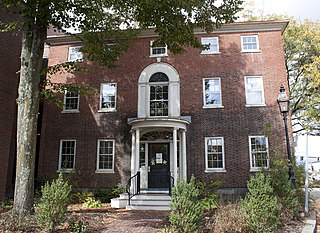
The Benedict House, also known as the Thomas Penhallow House, is a historic house at 30 Middle Street in Portsmouth, New Hampshire. Built in 1810–1813, it is a fine example of Federal style architecture, and may be an early work of the noted local builder Jonathan Folsom. The house was joined in 1954 to the adjacent Portsmouth Academy building when it housed the city's public library; this complex is now home to Discover Portsmouth, a local tourism promotion organization. It was listed on the National Register of Historic Places in 1973.
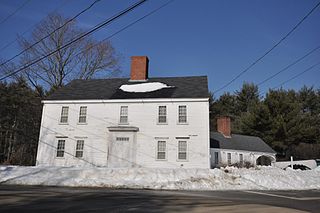
The Captain Jonathan Currier House is a historic house on Hillside Avenue in South Hampton, New Hampshire. Built about 1742, it is the oldest surviving house in Currierville, one of the early settlement areas in South Hampton. It was listed on the National Register of Historic Places in 1983.

